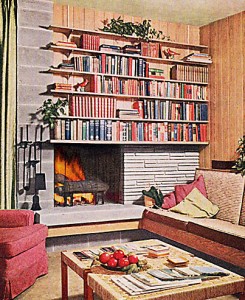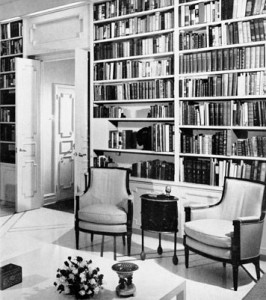The article Shelf Life in last Sunday’s New York Times magazine – insinuating that “traditional” book owners are pretentious phonies for shelving, stacking and throwing their books around their houses – is hypocritical (does it get any more pretentious than the author’s minimal yet highly curated little tableau of her Ebooks on display on that Conran’s shelf?), obvious, boring and annoying. I am countering it with excerpts from Roger Ebert’s online journal entry Books do Furnish a Life, and Steven Heller ‘s Observer piece Decorative Books: The End of Print, in support of those who phonily, pretentiously and unapologetically display their “traditional books”.
Excerpted from design observer:
When ink on paper finally goes the way of the Dodo (or the eight track), as certain dodos have predicted, heaps of printed papers will remain on earth. So the question will be what to do with what’s left? Ray Bradbury suggests in his 1953 dystopian science-fiction novel, Fahrenheit 451, that incineration is an option, but in truth the looming paper redundancy does not demand such hot draconian measures. When every bit of recorded human knowledge is digitized and available through Google or Jeeves alternative uses must be found for untold metric tons of paper, and particularly all those pesky books. So what is needed is the repurposing of these venerable materials into useful life-enhancing goods. Any suggestions? Â
Even before the advent of the digital information revolution, books were overshadowed by the specter of forced obsolescence. What does one do after reading the latest bestseller? Give or throw it away? Ultimately, books (read or not) end up on someone’s shelf somewhere, perhaps never to be handled again (other than to periodically dust them), which is reason enough to find new ways to imaginatively reuse them. So back in 1956, The New York Times promotion department provided a viable answer in the form of its The New York Times Shows You 65 Ways to Decorate with Books in Your Home, a book/zine with a reasonable $1 cover price. (I recently uncovered this lost document when the Times moved to its new headquarters.)
There was a time, not so very long ago,” wrote Betty Pepis, author of interior decoration books, in the introduction to 65 Ways to Decorate, “when books had little to do with the decorating of a home. Banished from the front parlor or the formal living room, they were confined to a den or a library reserved for the purpose… But homes have changed a great deal in the past two decades. Space is tighter. The front parlor is often the only parlor… So it has happened that books, of necessity, have become an inevitable part of the contemporary all-purpose living room… Integrating the library pleasantly into the home décor is a challenge that architects, designers and decorators have had to solve.”
If the past (51 years to be exact) foretells the future, there is hope on the horizon for books. Just as Ray Bradbury’s “firemen” in Fahrenheit 451 were the ones who incinerated books, maybe “book designer” will be a synonym for an interior decorator who uses books to enhance the environment. Such, I suspect, is the essence of today’s multiplatform design integration.
If you’re not acquainted with Roger Ebert’s online Journal, please do so immediately. He is a wit, a great brain and an inspiration. An excerpt from his 10/09 entry Books Do Furnish a Life:
Chaz and I have lived for 20 years in a commodious Chicago house with three floors, a furnished basement apartment and an exercise room we built on the roof-top deck. This house is not empty. To my 1965 edition of Shaw, which cost me about two quid and now sells for $119, Chaz and I have added, I dunno, maybe 3,000 or 4,000 books, countless videos and CDs, lots of art, rows of photographs, rooms full of comfortable furniture, a Buddha from Thailand, two elephants from India, African chairs and statues, and who knows what else.
Of course I cannot do without a single one of these possessions, including more or less every book I have owned since I was seven, starting with Huckleberry Finn. Other books I can’t throw away because–well, they’re books, and you can’t throw away a book, can you?
My possessions are getting away from me. We have an agreement. My office is my office. Chaz has her own book-filled office, and takes care that the rest of the house is clean and orderly. My office has a glass door with this gilt lettering: The Ebert Company, Ltd. 
Fine Film Criticism since 1967.
I have not been able to even get into the storage closet of my office for four years. The room is lined floor to ceiling with film books, and the shelves of directors and actors with names beginning H, I, J, K and L are blocked by piles of stuff on the floor. What? You expect me to throw out my first Tandy 100? And there’s a 40-year run of Sight and Sound there somewhere.
After being voted out of power in 1945, bi-polar autodidact Winston Churchill was humiliated and depressed. He retreated to his home library and spent six solid years reading an assortment of books, from Wuthering Heights to Gilbert and Sullivan to Nineteen Eighty-Four, which he read twice. He bounced back, re energized and ready for action. Much later in life, he gave up reading altogether and entered into debilitating “black dog” of depression.
“Beware the person of one book†~Latin proverb




